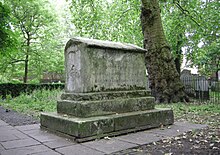Sir Gregory Page, 1st Baronet



Sir Gregory Page, 1st Baronet (c. 1669 – 25 May 1720), was a baronet in the Baronetage of Great Britain and a Member of Parliament in the Parliament of Great Britain.
He was the eldest son of Gregory Page (died 1693) and his second wife Elizabeth Burton. Page Senior was a wealthy London merchant, shipwright and director of the British East India Company, who owned a brewery in Wapping; he was an Alderman of the City of London in 1687. Elizabeth Burton was a widow from Stepney.[1][2]
Page Junior followed his father's footsteps as a brewer and merchant, building a vast fortune in trade with South and East Asia. He was elected to Parliament as Whig member for New Shoreham in West Sussex at a by-election in December 1708. He retained the seat, whose prime industry was shipbuilding, over two parliaments, despite accusations that he had bribed voters for their support.[2] He stood down at the British general election, 1713,[2] and was created a baronet on 3 December 1714.[3]
He returned to Parliament, again for New Shoreham, in the British general election, 1715, and again sat as a Whig, supporting the Hanoverian government until his death.[1][2]
He married on 21 January 1690 Mary Trotman, the 17-year-old daughter of Thomas and Mary Trotman of London.[3] They had four children: two sons (Gregory and Thomas) and two daughters (Mary and Sophia).[1][2][4]
He died on 25 May 1720, and was buried in linen[5] on 2 June 1720 at Greenwich. The baronetcy and his "immense fortune"[1] was inherited by his eldest son, Gregory. His widow died at Greenwich on 4 March 1729 aged 56. She was buried in a vault at Bunhill Fields on the outskirts of the City of London. Her epitaph hinted at a painful illness, which was possibly Meigs' syndrome.[6] The epitaph reads in part:[3][7]
In 67 months, she was tap'd [tapped] 66 times, Had taken away 240 gallons of water, without ever repining at her case, or ever fearing the operation.
The first baronet's second son, Thomas, married a sister of Viscount Howe and was buried, without issue,[4] at Greenwich on 4 November 1763. Gregory, the second baronet, died in 1776, when the baronetcy became extinct. The estate passed to Sir Gregory Turner, 3rd Baronet, who took the name Page-Turner in consequence. He was the grandson of the first baronet's daughter Mary (buried 18 February 1724 at Greenwich), who had married the first Turner baronet, Edward Turner.[3] The first baronet's other daughter Sophia was the first wife of Lewis Way (a member of the Inner Temple, director of the South Sea Company and president of Guy's Hospital). She died without issue on 2 January 1735.[8]
Arms
His coat of arms was Azure a fess indented between three martlets Or.[4]
References
- ^ a b c d Sedgwick, Romney R. (1970) "PAGE, Sir Gregory, 1st Bt. (c.1668–1720), of Greenwich", The History of Parliament: the House of Commons 1715–1754, edited by Romney Sedgwick
- ^ a b c d e Watson, Paula; Hayton, D. W. (2002) "PAGE, Gregory (c.1669–1720), of Greenwich, Kent", The History of Parliament: the House of Commons 1690–1715, edited by D. Hayton, E. Cruickshanks, S. Handley
- ^ a b c d Cokayne, George Edward (1906) Complete Baronetage. Volume V. Exeter: W. Pollard & Co. LCCN 06-23564. p. 24
- ^ a b c Wotton, Thomas; Kimber, Edward; Johnson, Richard A. (1771) The Baronetage of England, vol. 3, pp. 46–47
- ^ There was a £5 fine for burials not in wool, see Burying in Woollen Acts.
- ^ Griffin, J. P. (1996) "Dame Mary Page: the first recorded case of Meigs' syndrome?", Journal of the Royal College of Physicians of London, vol. 30, no. 5, p. 465 PMID 8912289
- ^ Bunhill Fields, Flickr photograph
- ^ Burke, John (1838) A Genealogical and Heraldic History of the Commoners of Great Britain and Ireland, Enjoying Territorial Possessions Or High Official Rank, vol. 4, p. 677
